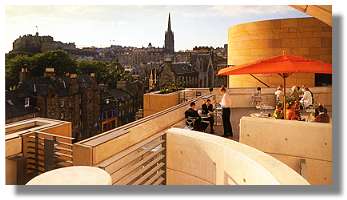
A Taste of Scotland
- A Guide to The Taste of Scotland Guide

Every year over 500 restaurants, hotel dining rooms, bistros, brasseries, and cafes apply for membership of A Taste of Scotland. It is a prestigious club and managers, owners and chefs all want to become members, offering public recognition that this is one of the best places to eat in Scotland. The beauty and strength of this elite "Club" is that it is open to all...
So jostling cheek by jowl in the Guide for 2001 you will find grand hotels and country pubs. So depending on your taste and budget, you could visit the classic, elegant grandeur of the Pompadour restaurant at Edinburgh's five star Caledonian hotel, where the food is described as complex, intricate and deftly handled, offering a fresh and world class menu such as this:
Compote of Western Isle seafood with fine leaves and basil oil.Alternatively the perennially popular Henderson's self service Salad Table, is an informal vegetarian bistro. Run by the Henderson family for generations they prove that wholefood can be delicious. There is a vast display of salads, savouries, quiches, puddings as well as daily specialities.
Pan Fried medallions of Aberdeen Angus beef with quails eggs and red wine mushroom jus,
Chocolate and pink grapefruit parfait, carmelised citrus fruits and Glenkinchie syrup.Broccoli and Dunsyre Blue Cheese soup with freshly baked nutty malt bread
Vegetarian haggis filo parcels with honey and Drambuie sauce,
Walnut Pie with creme fraicheAccording to the Guide, a "must do" on the Road to the Isles is the Old Library Lodge and restaurant at Arisaig. Owner Alan Broadhurst does most of the cooking and everything is sourced locally.
Pan fried cous cous coated goats cheese
Grilled local scallops on a celeriac puree
Lemon Tart with home made elderflower ice cream
If you enjoy seafood then head north to the Three Chimneys Restaurant on the Isle of Skye and enjoy a feast fit for Kings. Shirley Spear, a self taught cook has won numerous awards for excellence for her fish, lamb, beef and game dishes as well as home made breads, jams and the use of superb local cheeses.Terrine of Hot smoked salmon & monkfish, potato, leek and chervil
Fresh Skye lobster and langoustines with an avocado and sweet pepper salad
Cranachan parfait with fresh Skye raspberries and Three Chimneys shortbreadQuality food and fine dining in Scotland is therefore not reserved to the very expensive five star restaurant. In order to apply for membership the priority is a commitment to the very best fresh Scottish produce, skillfully prepared, cooked and presented. Applying for membership is the first step but you cannot buy your way in on a promise and a prayer. No establishment may be included without having passed a visit and report by a Taste of Scotland inspector. Their evaluation is based on very strict guidelines and points of criteria. The 14 inspectors all have a professional background in hotels, restaurants and catering industry and training and recruitment is rigorous to ensure consistency in the assessment process.
Inspectors visit incognito, as undercover agents, often travelling alone and do not disclose their identity until the last moment. They do not take notes during the meal, but are trained to be very observant with regard to every aspect of their surroundings, the other diners - (has anyone sent back a dish with a complaint?), - attention to detail, service, ambience and atmosphere and of course the quality and presentation of the food.
The points of criteria and guidelines for inspectors are all part of very rigid appraisal system so that each restaurant is judged on the same terms. The crucial concern is commitment to serving fresh, seasonal, locally grown produce wherever possible. Quality is a key word with freshly prepared meals being cooked and served to the highest standard appropriate to the category of the establishment.
The overall menu should be well balanced and illustrate the use of fresh foods throughout each course. Depending on whether it is a hotel or restaurant, all meals are assessed, breakfast, lunch and dinner to show consistency of quality. Descriptions on a menu must be accurate and truthful - ie freshly squeezed orange juice does not come out of a carton!.
For main meals, attractive presentation is an important attribute and back to attention to detail. Culinary skills are assessed by the quality, texture, temperature, flavour, taste, balance and overall creative imagination of each dish. Inspectors are not food critics as such. Subjective opinion is not relevant in terms of what kinds of food they may wish to choose. The criteria is simple, fresh, Scottish ingredients, well prepared and served. The wine list is also noted for knowledge and good selection.
Inspectors observe everything from the manner in which they are welcomed and assisted on arrival. The appearance and manner of all staff is noted, especially in respect of those preparing food, in accordance with food hygiene. The standard of furnishings, design, layout, lighting, music, and heating and cleanliness of the restaurant and of course the toilets is also part of the intricate judging process.
The inspector reveals his or her identity at the end the meal or overnight stay and immediately gives a verbal appraisal. A full report is then completed and based on this and other considerations and views, the restaurant either fails or passes the test for A Taste of Scotland membership. Constructive criticism and advice is offered if a restaurant fails the mark in certain areas so that they can improve standards and try again the next year.
Out of the 500 establishments who apply for membership, around 400 usually make the grade. And all those great places to eat and stay in this year's guide will have to apply again for membership for the following year. Once again the inspector calls....
Next page > The Macallan Awards > Page 1, 2, 3.
Where else would you like to go in Scotland?

